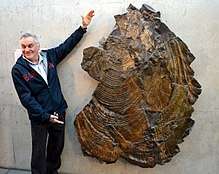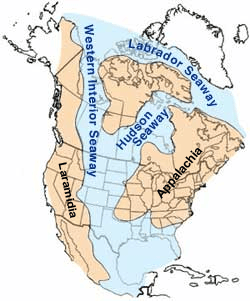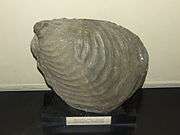Inoceramus
| Inoceramus | |
|---|---|
 | |
| A 187 cm (74 in) Inoceramus/Sphenoceramus steenstrupi fossil found on the Nuussuaq Peninsula | |
| Scientific classification | |
| Kingdom: | Animalia |
| Phylum: | Mollusca |
| Class: | Bivalvia |
| Subclass: | Cryptodonta |
| Order: | Praecardioida |
| Family: | Inoceramidae |
| Genus: | Inoceramus Sowerby, 1814 |
| Species | |
|
See text | |
Inoceramus (Greek: translation "strong pot") is an extinct genus of fossil marine pteriomorphian bivalves that superficially resembled the related winged pearly oysters of the extant genus Pteria. They lived from the Early Jurassic to latest Cretaceous.[1]
Taxonomy
The taxonomy of the inoceramids is disputed, with genera such as Platyceramus sometimes classified as subgenus within Inoceramus. Also the number of valid species in this genus is disputed.
Description
Inoceramids had a thick shell paved with "prisms" of calcite deposited perpendicular to the surface, which gave it a pearly luster in life.[2] Most species have prominent growth lines which appear as raised semicircles concentric to the growing edge of the shell. Paleontologists suggest that the giant size of some species was an adaptation for life in the murky bottom waters, with a correspondingly large gill area that would have allowed the animal to survive in oxygen-deficient waters.[2]
Selected species
- I. aequicostatus † Voronetz 1937
- I. albertensis † McLearn 1926
- I. altifluminis † McLearn 1943
- I. americanus † Walaszczyk & Cobban 2006
- I. andinus † Wilckens 1907
- I. anglicus † Woods 1911
- I. anilis † Pcelinceva 1962
- I. anomalus † Heine 1929
- I. anomiaeformis † Feruglio 1936
- I. apicalis † Woods 1912
- I. arvanus † Stephenson 1953
- I. bellvuensis †
- I. biformis † Tuomey, 1854
- I. brownei † Marwick 1953
- I. carsoni † McCoy 1865
- I. comancheanus †
- I. constellatus † Woods 1904
- I. corpulentus † McLearn 1926
- I. coulthardi † McLearn 1926
- I. cuvieri † Sowerby 1814
- I. dakotensis †
- I. dominguesi † Maury 1930
- I. dowlingi † McLearn 1931
- I. dunveganensis † McLearn 1926
- I. elburzensis † Fantini 1966
- I. everesti † Oppel 1862
- I. fibrosus † Meek & Hayden 1857
- I. formosulus † Voronetz 1937
- I. fragilis † Haal & Meek 1856
- I. frechi † Flegel 1905
- I. galoi † Boehm 1907
- I. gibbosus †
- I. ginterensis † Pergament 1966
- I. glacierensis † Walaszczyk & Cobban 2006
- I. haasti † Hochstetter 1863
- I. howelli † White 1876
- I. incelebratus † Pergament 1966
- I. inconditus † Marwick 1953
- I. kystatymensis † Koschelkina 1960
- I. lamarcki † Parkinson 1819
- I. lateris † Rossi de Gargia & Camacho 1965
- I. mesabiensis † Bergquist 1944
- I. morii † Hayami 1959
- I. multiformis † Pergament 1971
- I. mytiliformis † Fantini 1966
- I. nipponicus † Nagao & Matsumoto 1939
- I. perplexus †
- I. pictus †
- I. pontoni † McLearn 1926
- I. porrectus † Voronetz 1937
- I. prefragilis † Stephenson 1952
- I. proximus † Tuomey, 1854
- I. pseudolucifer † Afitsky 1967
- I. quenstedti † Pcelinceva 1933
- I. robertsoni † Walaszczyk & Cobban 2006
- I. sakatchewanensis † Warren 1934
- I. selwyni † McLearn 1926
- I. sokolovi † Walaszczyk & Cobban 2006
- I. steinmanni † Wilckens 1907
- I. subdepressus † Meek & Hayden 1861
- I. tenuirostratus † Meek & Hayden 1862
- I. triangularis † Tuomey, 1854
- I. undabundus † Meek & Hayden 1862
- I. ussuriensis † Voronetz 1937
Distribution

Species of Inoceramus had a worldwide distribution during the Cretaceous and Jurassic periods (from 189.6 to 66.043 Ma).[1] Many examples are found in the Pierre Shale of the Western Interior Seaway in North America. Inoceramus can also be found abundantly in the Cretaceous Gault Clay that underlies London. Other locations for this fossil include Vancouver Island,[2] British Columbia, Colombia (Hiló Formation, Tolima and La Frontera Formation, Boyacá, Cundinamarca and Huila),[3] Spain, France, Germany, Afghanistan, Albania, Algeria, Angola, Antarctica, Argentina, Australia, Austria, Brazil, Bulgaria, Canada (Alberta, Northwest Territories, Nunavut, Saskatchewan, Yukon), Chile, China, Cuba, the Czech Republic, Denmark, Ecuador, Egypt, Greenland, Hungary, India, Indian Ocean, Iran, Italy, Jamaica, Japan, Jordan, Kenya, Libya, Madagascar, Mexico, Morocco, Mozambique, Nepal, New Caledonia, New Zealand, Nigeria, Papua New Guinea, Peru, Poland, the Russian Federation, Saudi Arabia, Serbia and Montenegro, South Africa, Sweden, Switzerland, Tunisia, Turkey, Turkmenistan, the United Kingdom, United States (Alabama, Alaska, Arizona, Arkansas, California, Colorado, Delaware, Idaho, Iowa, Kansas, Maryland, Minnesota, Mississippi, Montana, Nebraska, New Jersey, New Mexico, North Carolina, North Dakota, Oregon, South Carolina, South Dakota, Tennessee, Texas, Utah, Washington, Wyoming), and Venezuela.[1]
Gallery
 Inoceramus from the Cretaceous of South Dakota
Inoceramus from the Cretaceous of South Dakota- Inoceramus proximus
 Inoceramus cuvieri
Inoceramus cuvieri Inoceramus vancouverensis
Inoceramus vancouverensis- Inoceramus hobetsensis
References
- 1 2 3 Inoceramus at Fossilworks.org
- 1 2 3 Ludvigsen & Beard, 1997, pp.102-103
- ↑ Acosta & Ulloa, 2001, p.41
Bibliography
- Ludvigsen, Rolf; Beard, Graham (1997). West Coast Fossils: A Guide to the Ancient Life of Vancouver Island. pp. 102–103.
- Acosta Garay, Jorge; Ulloa Melo, Carlos E (2001). Geología de la Plancha 208 Villeta - 1:100,000 (PDF). INGEOMINAS. pp. 1–84. Retrieved 2017-04-04.
Further reading
- Kennedy, W.J.; Kauffman, E.G.; Klinger, H.C. (1973). "Upper Cretaceous Invertebrate Faunas from Durban, South Africa". Geological Society of South Africa Transactions. 76 (2): 95–111.
- Klinger, H.C.; Kennedy, W.J. (1980). "Upper Cretaceous ammonites and inoceramids from the off-shore Alphard Group of South Africa". Annals of the South African Museum. 82 (7): 293–320.
- Gebhardt, H. (2001). "Inoceramids, Didymotis and ammonites from the Nkalagu Formation type locakity (late Turonian to Coniacian, southern Nigeria): biostratigraphy and palaeoecologic implications". Neues Jahrbuch für Geologie und Palaeontologie, Monatshefte. 4: 193–212.
- El Qot, G.M. (2006). "Late Cretaceous macrofossils from Sinai, Egypt". Beringeria. 36: 3–163.
External links
| Wikimedia Commons has media related to Inoceramus. |